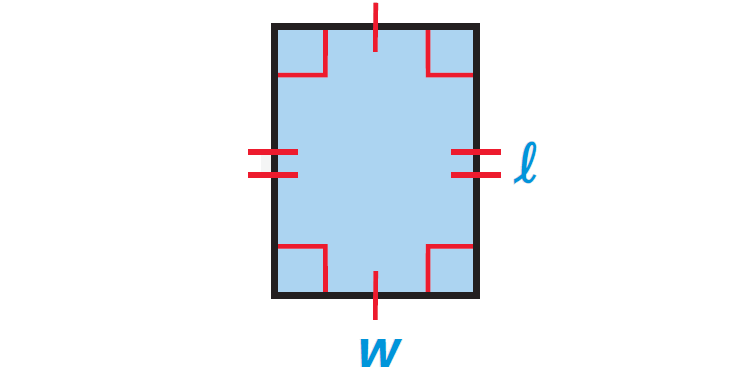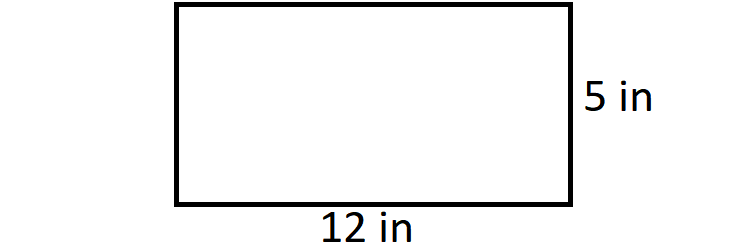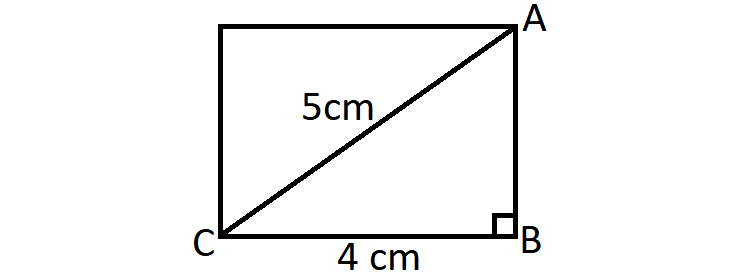FINDING THE PERIMETER AND AREA OF A RECTANGLE
Subscribe to our ▶️ YouTube channel 🔴 for the latest videos, updates, and tips.
Perimeter :
Perimeter is a path that surrounds a rectangle. The term may be used either for the path or its length it can be thought of as the length of the outline of the rectangle.
Area :
Area of a rectangle is defined as the space occupied by the rectangle shaped object on a flat surface. The area of a shape can be measured by comparing the shape to squares of a fixed size.
Formulas for Perimeter and Area of a Rectangle

length = l and width = w
Perimeter = 2l + 2w
Area = lw
The measurements of perimeter use units such as centimeters, meters, kilometers, inches, feet, yards, and miles. The measurements of area use units such as square centimeters (cm2), square meters(m2), and so on.
Example 1 :
Find the perimeter and area of a rectangle of length 12 inches and width 5 inches.
Solution :
Draw a rectangle and label the length and width.

|
Perimeter = 2l + 2w = 2(12) + 2(5) = 24 + 10 = 34 |
Area = lw = 12 ⋅ 5 = 60 |
So, the perimeter is 34 inches and the area is 60 square inches.
Example 2 :
The area of a rectangle is 56 square inches. If the length is 8 inches, find the width of the rectangle.
Solution :
Given : Area of the rectangle = 56 sq. in.
lw = 56
Substitute l = 8.
8w = 56
Divide both sides by 8.
w = 7 in
Example 3 :
The perimeter of a rectangle is 30 cm. The length is 3 more than twice the width. Find the length and width of the rectangle.
Solution :
Step 1 :
Let w = x.
Then, l = 2x + 3.
Step 2 :
Given : Perimeter of the rectangle = 30 cm.
2l + 2w = 30
Step 3 :
Substitute w = x and l = 2x + 3.
2(2x + 3) + 2x = 30
4x + 6 + 2x = 30
6x + 6 = 30
Subtract 6 from both sides.
6x = 24
Divide both sides by 6.
x = 4
Width = x = 4.
Length = 2x + 3 = 2(4) + 3 = 11.
So, the length is 11 cm and width is 4 cm.
Example 4 :
The diagonal of a rectangle is 5 cm and one of its sides is 4 cm. Find its area.
Solution :
Step 1 :
Let us assume that one of the sides given is length.
Then, l = 4 cm.
Step 2 :
Draw a rectangle and label the diagonal and length.

Step 3 :
To find area of a rectangle, we need the measures of length and width. We know the length and it is 4 cm. We have to find the width.
Step 4 :
In the rectangle above, let us consider the right triangle ABC and apply Pythagorean theorem.
AB2 + BC2 = AC2
Substitute BC = 4 and AC = 6.
w2 + 42 = 52
w2 + 16 = 25
Subtract 16 from both the sides.
w2 = 9
w2 = 32
Remove the exponent 2 on both sides.
w = 3 cm
Step 5 :
Area of the rectangle = lw
Substitute l = 4 and w = 3.
= 4 ⋅ 3
= 12 cm2
Subscribe to our ▶️ YouTube channel 🔴 for the latest videos, updates, and tips.
Kindly mail your feedback to v4formath@gmail.com
We always appreciate your feedback.
About Us | Contact Us | Privacy Policy
©All rights reserved. onlinemath4all.com

Recent Articles
-
10 Hard SAT Math Questions (Part - 45)
Jan 18, 26 06:52 PM
10 Hard SAT Math Questions (Part - 45) -
10 Hard SAT Math Questions (Part - 44)
Jan 12, 26 06:35 AM
10 Hard SAT Math Questions (Part - 44) -
US Common Core K-12 Curricum Algebra Solving Simple Equations
Jan 07, 26 01:53 PM
US Common Core K-12 Curricum Algebra Solving Simple Equations
